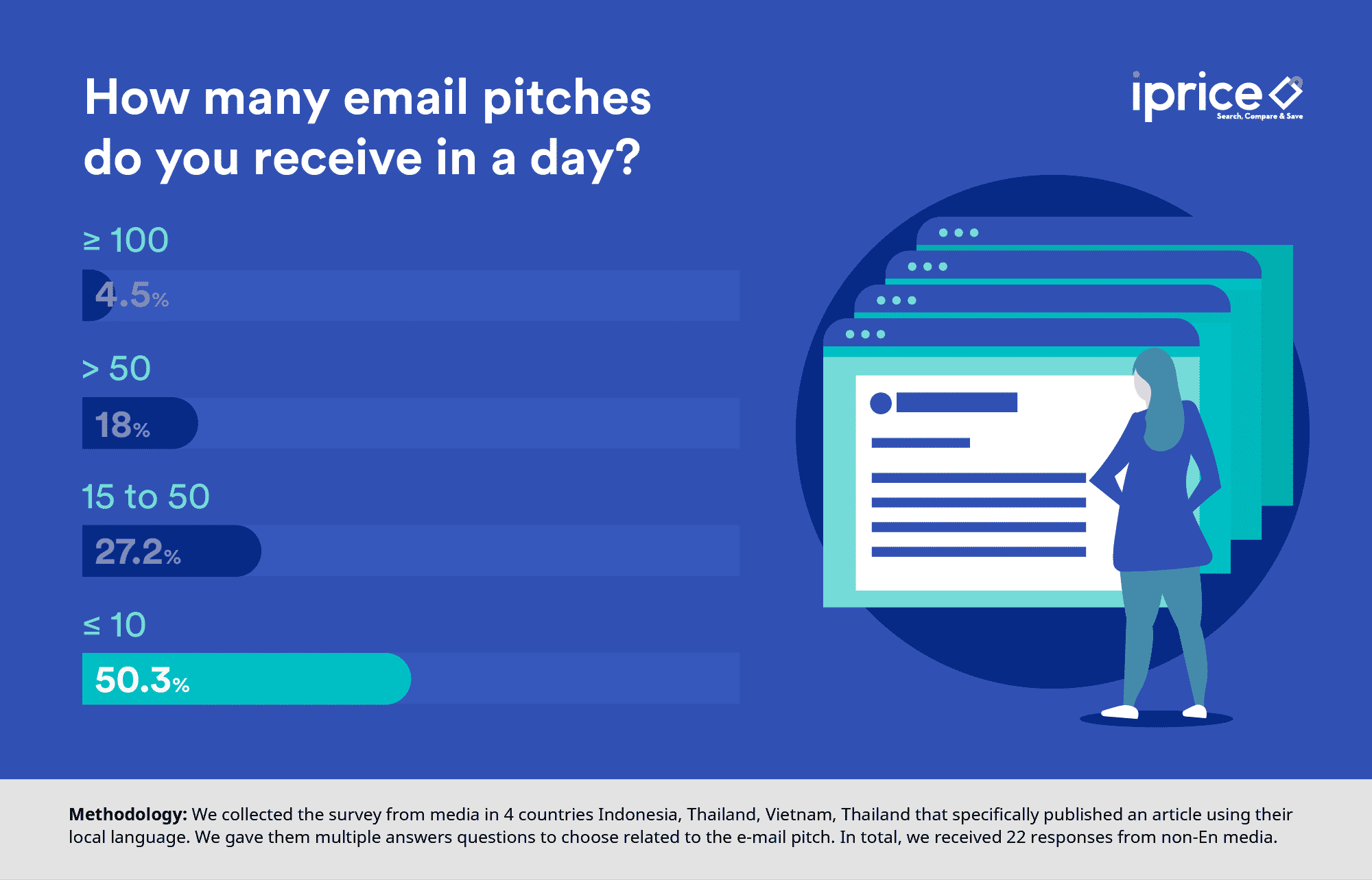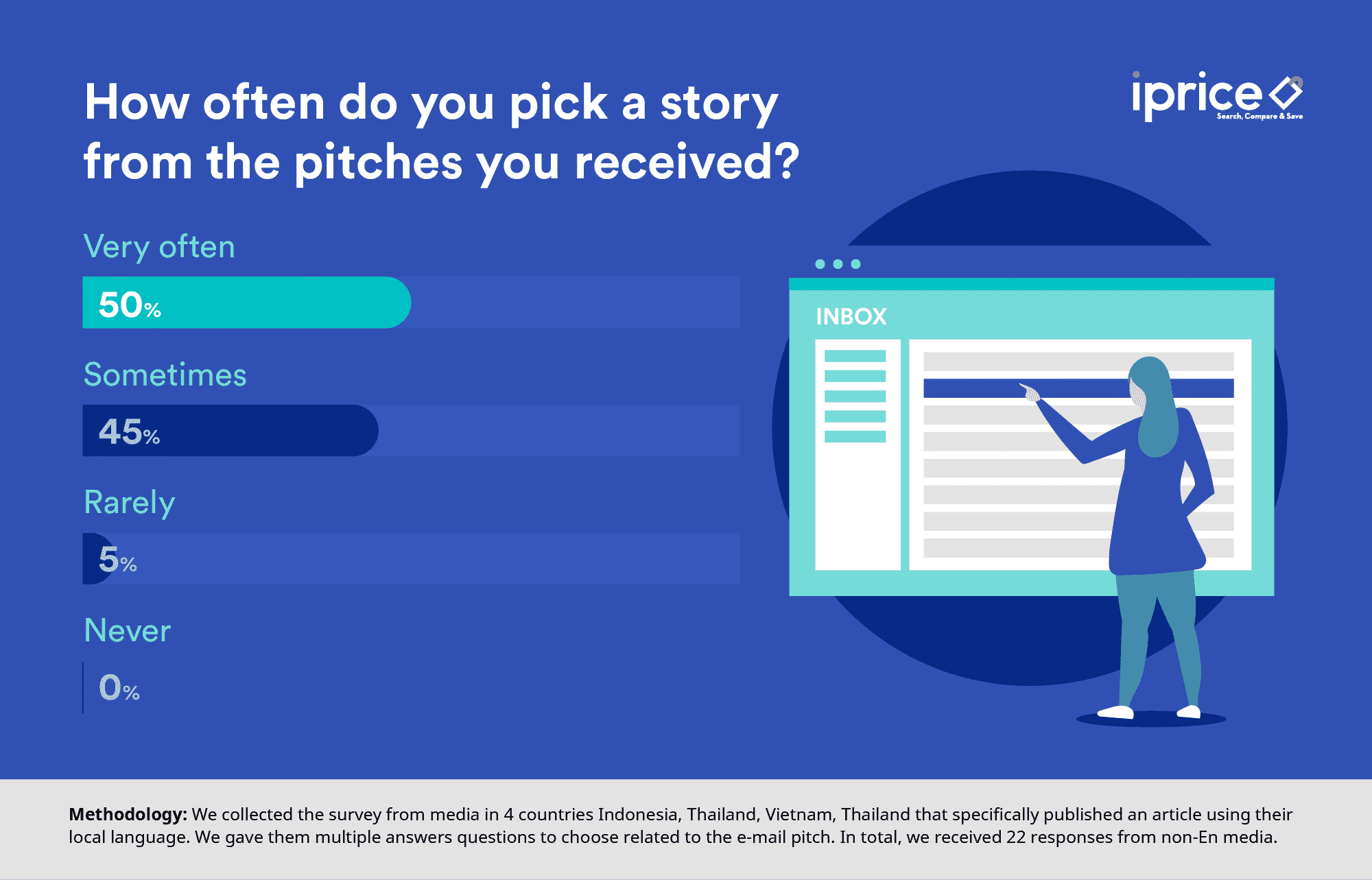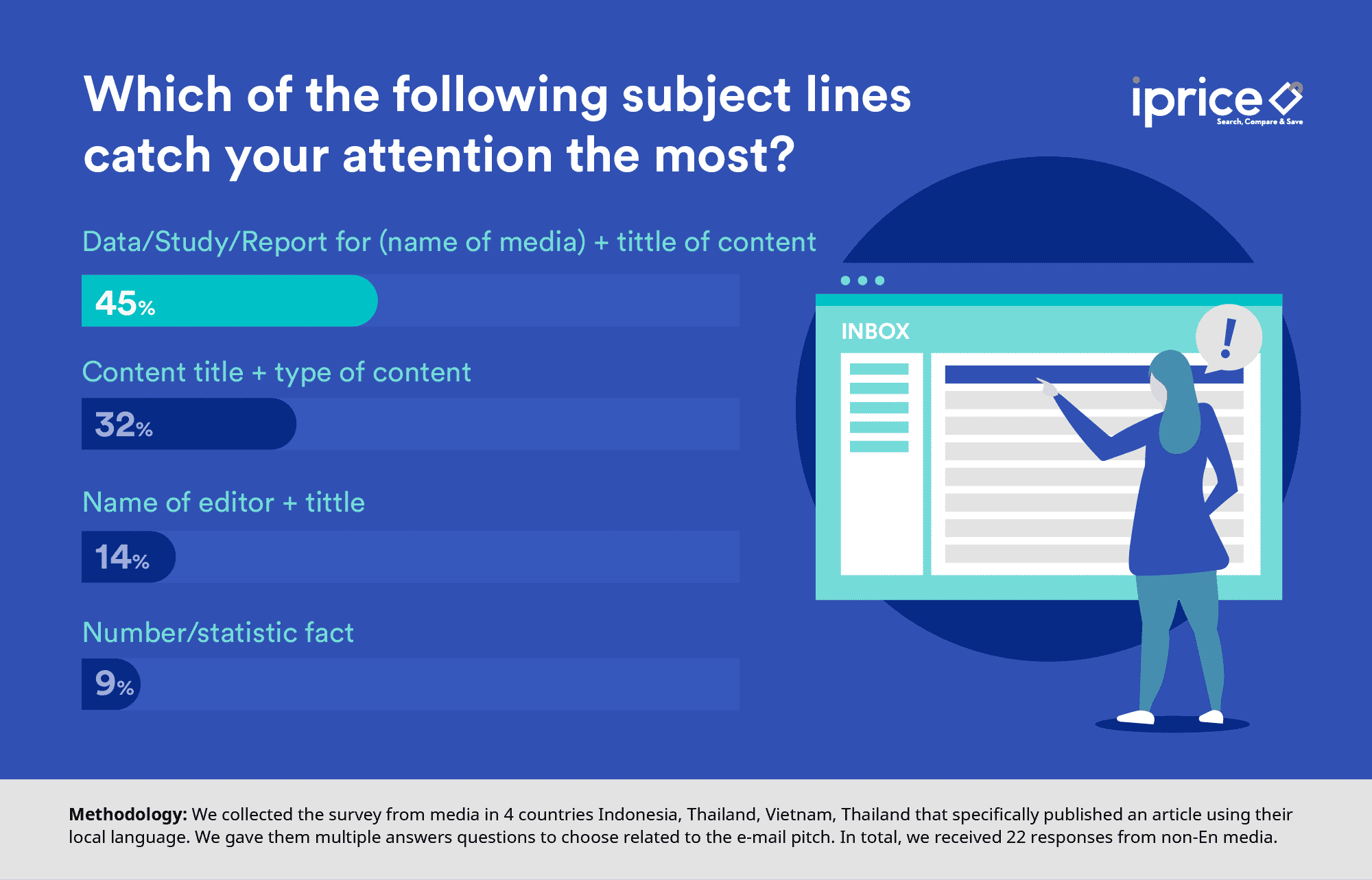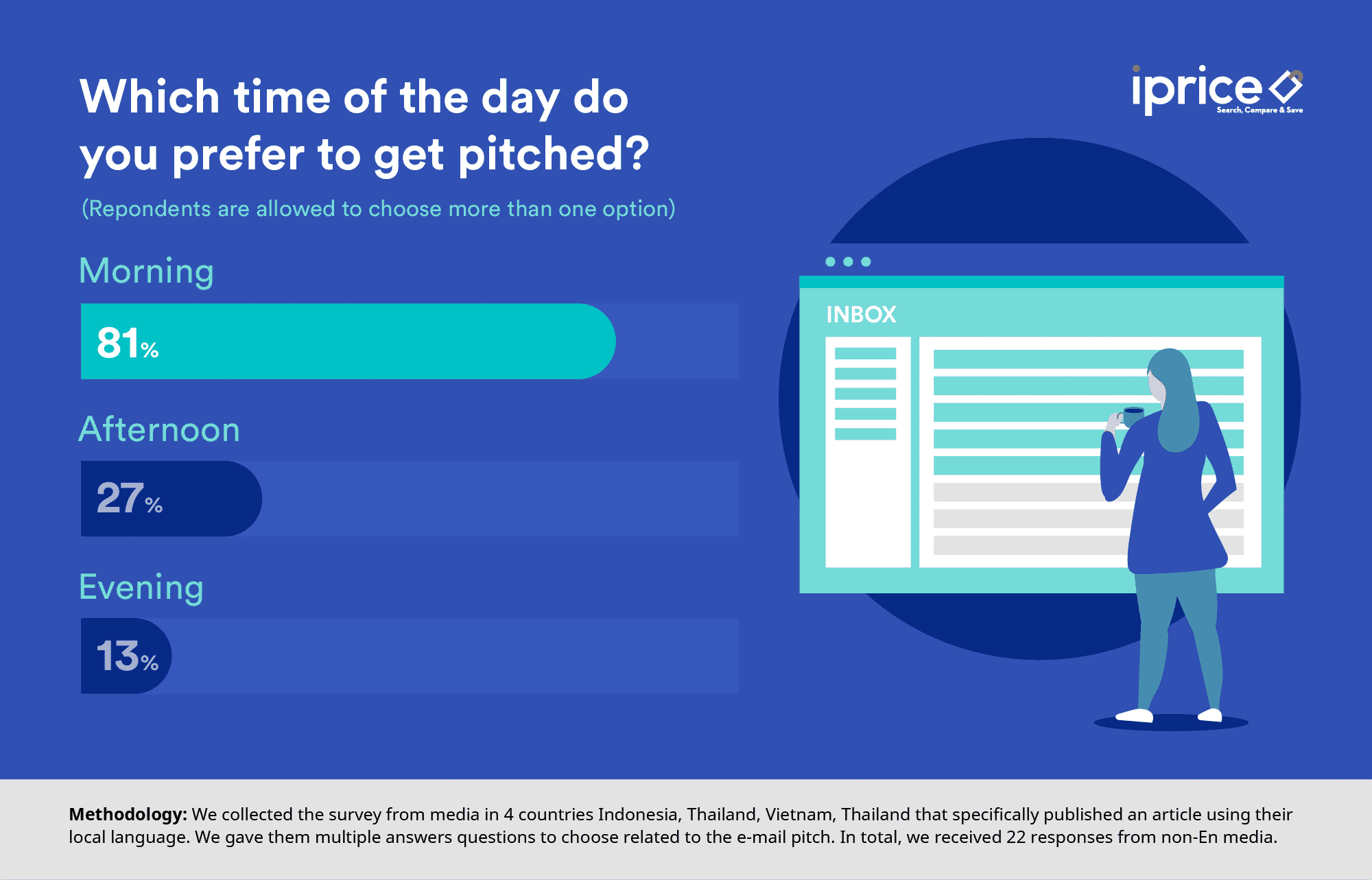Author, Vivin Dian Devita
This study was inspired by Fractl, which talks about how to pitch to publishers by using 20 open-ended questions to 500 media. Since our content marketers operate in Southeast Asia, we worked closely with non-English journalists from Thailand, Indonesia, the Philippines, and Vietnam. Our main goal is to understand how to pitch to non-English media better by using similar questions that are focused on the structure of the Email pitch.
In total, we managed to receive 22 responses from our closest media friends across the four countries. This study may not reflect the overall media preference in general, but we hope to share some of the insights we gathered, which can be used as brief guidelines on pitching to non-English media in Southeast Asia. After distributing a 7-question multiple-choice survey, we managed to gather some interesting findings we’d like to share with you:
Pitch Your Content

Most of the participating journalists we met with were senior editors and surprisingly, they received less than 10 emails a day. Only 4.5% of them received more than 100 emails and the reason for it is due to the general redaction email, which automatically forwards to their work email addresses.
Some of the respondents reported that they not only received email pitches but they also often received reports from the general public. Nowadays, people are more engaged by capturing interesting situations in their surroundings and then by sending footage to the media. This means that our pitches need to be outstanding with new and insightful data. Oftentimes, they also pick up stories that are related to the topics they are writing about that day or week. So if they don’t respond to your email right away, don’t panic. The key is to wait; journalists are often too busy to respond to emails one by one right away. It doesn’t necessarily mean your story is unappealing to them.

According to the Fractl research, they concluded that most of the journalists prefer exclusive data. Similarly, journalists in Indonesia, Philippines, Thailand, and Vietnam also prefer exclusive content. In our study, we let the journalists choose more than one type of content and 72% of the respondents chose data-driven content as the most interesting topic that they would likely pick up. The Fractl study also tells us how data-driven content will earn long-term links.
In iPrice, we make sure to create Evergreen content (content that is always relevant and not time-sensitive), such as our Map of E-commerce report, which is an exclusive data-driven content that ranks the E-commerce players in each of our Southeast Asian markets. This content is considered to be an Evergreen content because the data is continuously being updated and deems to be relevant to journalists and industry stakeholders. Based on our experience, this content garners several media publications and links upon distribution. Our insight on this is aligned with MOZ’s recent study when they used BuzzSumo to find content that was considered as evergreen and data-driven.

50% of non-English journalists often pick up content from the pitches they receive. This result is quite different from Fractl’s, where most of their respondents stated that they only sometimes pick up pitched content. This result may not reflect the non-English media as a whole, but these insights have proven to be effective for our team. We also gathered these insights from our closest media friends, which we hope have answered this survey with transparency.
Another insight we could provide is that maintaining a close relationship with receptive media has consistently garnered us media publication and links. Neil Patel shared that building rapport with journalists is one of the most important steps that will help us get media coverage because a successful media outreach is about building relationships.
Double-check your Email

I’ve developed the habit of sending my email pitches to my personal Gmail before sending it out to the media. This allows me to see the email format clearly and how it would look in other platforms (we use Outlook at the office) and devices. Oftentimes, it would take me a few times to revise and reformat the spacing so it wouldn’t look so congested for the receiver, no matter what platform or device they use to open the email.
Our study concludes that the majority of the journalists (59%) initially access their Emails via their mobile phones and would only open an email pitch from a computer if they find it interesting enough. However, if they feel like the email is too congested to read, they usually ignore or delete the email without even opening it from their computers.
Email Headline

The email subject is the most crucial thing when it comes to outreach. MOZ’s Whiteboard Friday Link Building Outreach explained that email subjects play an important role in the rate of opened emails. We can’t really expect our content to be picked up if they don’t even take a look at our email, right?
A study by Aira states that email subjects that contain words like “data” will increase the chances of your email being opened by 52%. Hence, in our survey, we provided email subject options for the respondents to choose as the most appealing. 45% of the respondents are more likely to open emails with subjects that contain words like “data,” “report,” and/or “study,” while 32% of them chose subjects with the title of the content, and only 14% chose subjects with the name of the editor. Make sure to keep your email subject short and sweet so it doesn’t get cut off. A study by Marketingland recommends us to keep it between 6-10 words to increase the likelihood of our emails being opened.
When to pitch your content?

We asked the journalists when it’s the best time for them to receive email pitches and about 81% of them prefer to receive these in the morning. Research by HubSpot, written by Kayla Carmicheal, confirms our results as it states that the highest click-to-open rate of Emails is at 10 AM. HubSpot’s results were based on 4 billion emails from 1,000 active senders. HubSpot also suggests that we send emails in the morning, around 8:00 – 9:30 AM, to match the audience’s daily routine.
If you are pitching to international media, the time should be adjusted based on the local time of the receiver. Respondents from our survey shared that if they receive email pitches early in the morning, there is an increased chance that our content will be featured on the same day, especially if they are already writing about a similar topic. Hence, our content can be one of their data resources.

My team was interested to find out whether it was fine to send email pitches during the weekend. Interestingly enough, the answer is both yes and no. According to the results of our survey, 72.6% of the journalists answered that they were fine with receiving pitches during the weekend. However, it is important to note that some are likely to check these during a weekday. This risks your email being buried by other mail during the days that would pass until Monday.
Other journalists, however, responded that they work over the weekends so they are able to open email pitches at this time as they don’t stop writing news even on Sundays. However, we also received feedback that sending an email during the weekend will be considered impolite in Thailand as it shows disrespect to their “rest time.” Personally, I prefer to send emails on weekdays, or latest by Friday evening, especially if we produce timely content in line with trends or if I purposely want this story to be published during the weekend.
We suggest to personally ask your media friends if they are fine with receiving pitches on weekends but make sure you already have a good relationship with them before doing so. As link-builders, we work closely with a lot of external parties, so it’s very important for us to maintain a good relationship with them. An earlier study published on HBR and Medium also suggests keeping your email in the draft folder first and sending it first thing on Monday if it’s really urgent.
In a nutshell, we’re sure you have written some content masterpieces and put a lot of effort into writing these. Therefore, we hope that applying our insights and findings can help increase your chances of getting more media publications in Southeast Asia. Lastly, always remember to personalise each email.
Written by Vivin Dian Devita, Content Marketer from iPrice Group
iPrice curates highly insightful data that are unique and unbiased in the world of tech, e-commerce, and online retail by providing data-rich, interactive, and media-specific targeted content that varies from the latest tech trends to the top e-players in Southeast Asia. They also provide high-quality country-specific insights and data on seven markets, namely Singapore, Hong Kong, Vietnam, Thailand, Indonesia, Malaysia, and the Philippines. Through collaborations with data partners such as App Annie Intelligence, SimilarWeb, and Parcel Perform, iPrice has been featured on numerous prominent publications including South China Morning Post, Bloomberg, Motley Fool, Nasdaq, IGN, and Tech Crunch, to name a few.



















